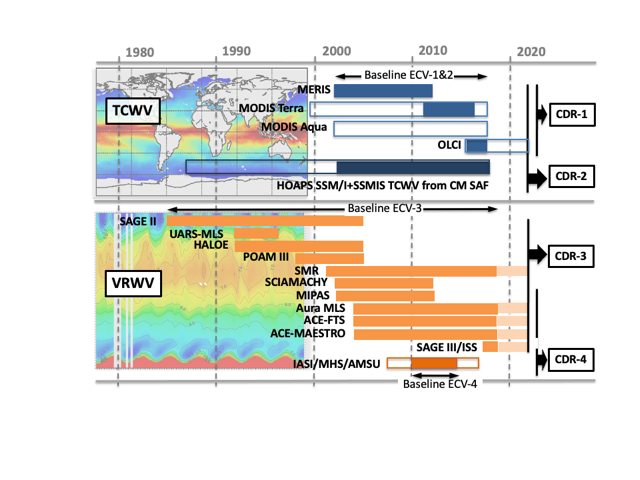About
Water vapour (H₂O) in the atmosphere is a key component of the Earth’s hydrological cycle, critical in shaping the global environment and supporting life on Earth as we know it.
Manifold physical processes thereby help redistributing the water from the oceans to the land involving the formation of clouds, precipitation, and extreme weather events. Water vapour also has a key role in constraining the Earth’s energy balance. It is the single most important natural greenhouse gas in the atmosphere and constitutes a strong positive feedback to anthropogenic climate forcing from carbon dioxide (CO₂).
The water vapour feedback is critically important in understanding past and determining future climate change and its global and regional impacts. It is due to its importance, that GCOS has identified water vapour as an essential climate variable (ECV). However, the properties of the Earth’s atmospheric water vapour distribution challenge not only climate research, but also Earth Observation science, from instrument development to retrieval science. ESA’s Water Vapour_cci project is helping to consolidate our knowledge of past changes as derived from observations and to establish climate data records for use in climate research.
Data Availability
Please read below for full details on the four Climate Data Records that are being generated by the Water Vapour_cci project. Three CDRs are available now:
- Two CDRs are available via the Open Data Portal:
- Total column water vapour over land, CCI TCWV-land (CDR-1)
- Vertically resolved water vapour in the stratosphere, CCI WV-strato (CDR-3)
- One CDR is available via the EUMETSAT CM SAF:
- Total column water vapour over land and ocean, CM SAF/CCI TCWV-global (COMBI) (CDR-2)
Early access to unpublished datasets can be requested by contacting the science lead of the team in Contacts.
Objective
The ultimate objective of the Water Vapour_cci project is to generate new global high-quality climate data records of both total column and vertically resolved water vapour, which are homogeneous in space and time, work towards fulfilling GCOS requirements, and respond to the user needs of the climate research community in the best possible way.
At the same time, this project will optimise the temporal and spatial resolution of these climate data records with respect to the assessed limitations of available observing systems and quantify uncertainties that are useful to the end users. The project will also analyse climate variability and trends in atmospheric water vapour on different spatial and temporal scales, and consistency between observations and theoretical expectations using comparisons to ERA5 and climate models in the CMIP context, in order to advance our scientific understanding of the importance of water vapour in the climate system and to support climate services such as the Copernicus Climate Change Service (C3S).
The Water Vapour project is in the process of generating four key deliverables, which include Climate Data Records (CDRs) of both total column water vapour over land and ocean (CDR-1 and CDR-2), and vertically resolved water vapour (CDR-3 and CDR-4, see Figure 1). These CDRs are working towards satisfying key user requirements of the climate research community that were defined at the beginning of the project and are being updated throughout the lifetime of the project.
If you want to get involved in the user group of our water vapour products and help define climate data record requirements, please contact the science lead of the Water Vapour project. Below follow short descriptions of the different CDRs.

Figure 1: Key deliverables: The climate data records derived from a range of instruments include both total column (TCWV) and vertically resolved (VRes WV) information on water vapour.
CDR-1: Total column water vapour over land (CCI TCWV-land). A total column water vapour CDR that is based on near-infrared (NIR) observations from MERIS, MODIS and OLCI. The ECV spans the time period 2002 to 2017 with a spatial resolution of 0.05°/0.5° and as daily averages. Key challenges were harmonising the time series due to issues around calibration performance, long-term stability and inconsistency between the single sensor records.
CDR-2: Total column water vapour over land and ocean (CM SAF/CCI TCWV-global (COMBI)). CDR-1 is combined with ocean observations from microwave imager measurements (e.g. SSM/I and SSMIS) from EUMETSAT CM SAF. The combined product will span the time period 2002 to 2017 with a spatial resolution of 0.05°/0.5° and as daily averages. The combined product makes use of the spatial complementarities of the land-based NIR and ocean-based microwave observations without changing the characteristics of the original products. Thus, the combined product has global coverage and will be jointly released by Water_Vapour_cci and CM SAF. Key challenges are to fill coastal and ice covered areas and to achieve consistency between both products.
CDR-3: Vertically resolved water vapour in the stratosphere (CCI WV-strato). A vertically resolved water vapour CDR for the stratosphere will be merged using a range of ESA, third-party and NASA instruments (including SAGE II, HALOE, POAM III, Odin SMR, MIPAS, SCIAMACHY, GOMOS, ACE-MAESTRO, ACE-FTS and Aura-MLS) and spanning the time period 1985 to the end of 2019. This database will have monthly time resolution and represent a zonal mean database.
CDR-4: Vertically resolved water vapour in the upper troposphere and lower stratosphere (CCI WV-UTLS). A second vertically resolved water vapour CDR spanning the troposphere and the stratosphere and being resolved latitudinally, longitudinally and monthly will be merged from a tropospheric product (i.e. the IASI-based IMS product) and several stratospheric products from still-operating satellite limb sounders (Aura-MLS, ACE-FTS, ACE-MAESTRO). The key challenge is the merging across the tropopause, which is the interface between the troposphere and the stratosphere with very complex dynamical, physical, and chemical properties, greatly challenging the performance of EO instruments.
The derived CDRs will be validated and fully characterised by our validation team (Val) and then passed on to our climate research group (CRG) who will perform dedicated process and climate studies which aim at testing the usefulness of the new products and derive new knowledge related to the study of water vapour in the atmosphere.

